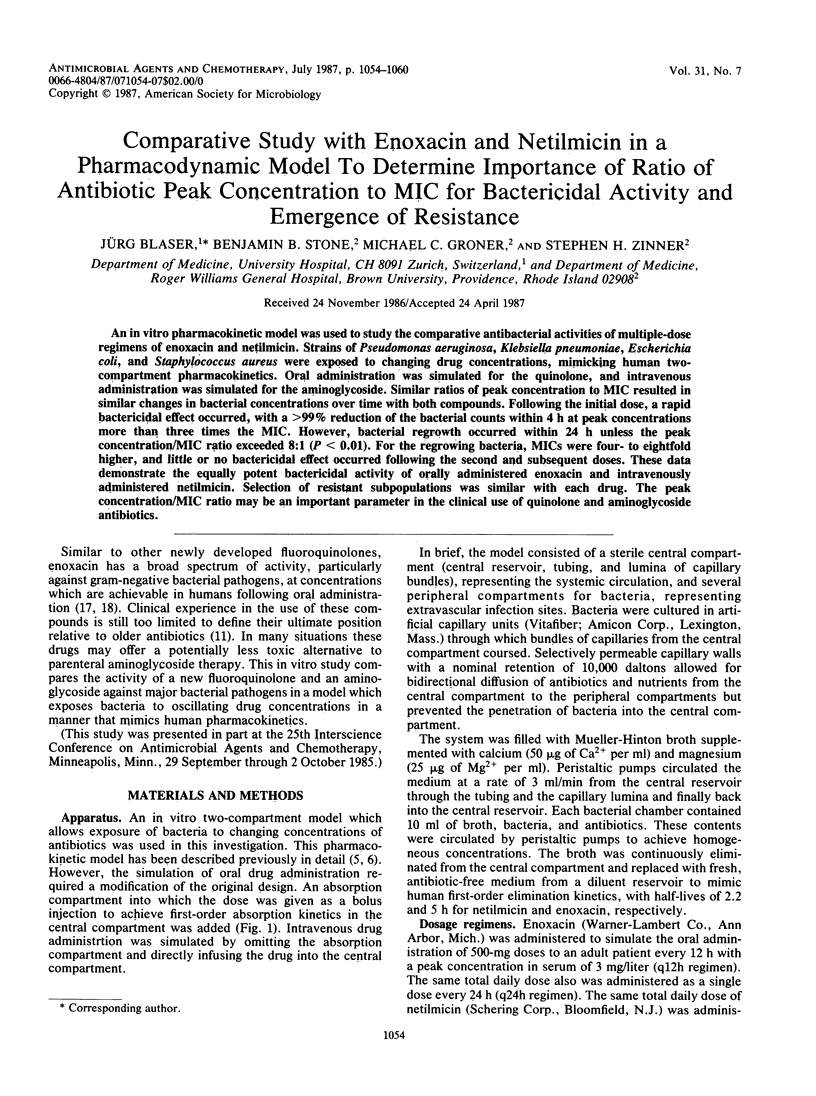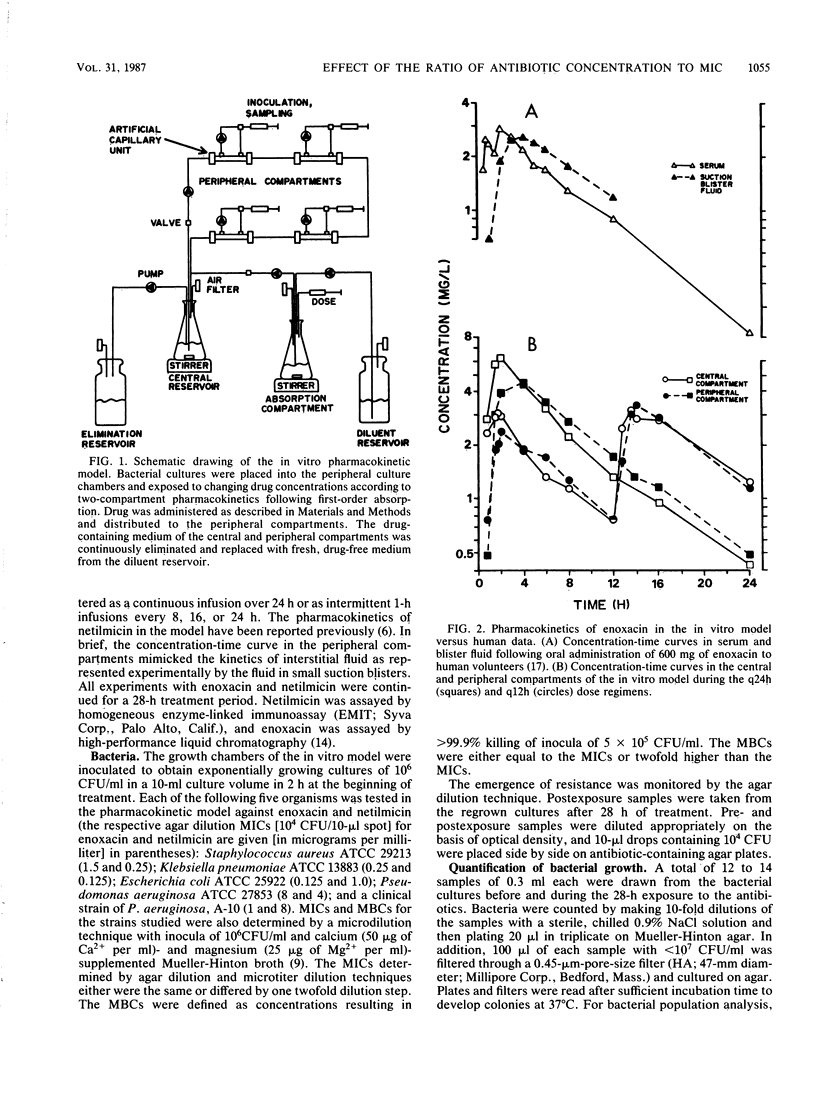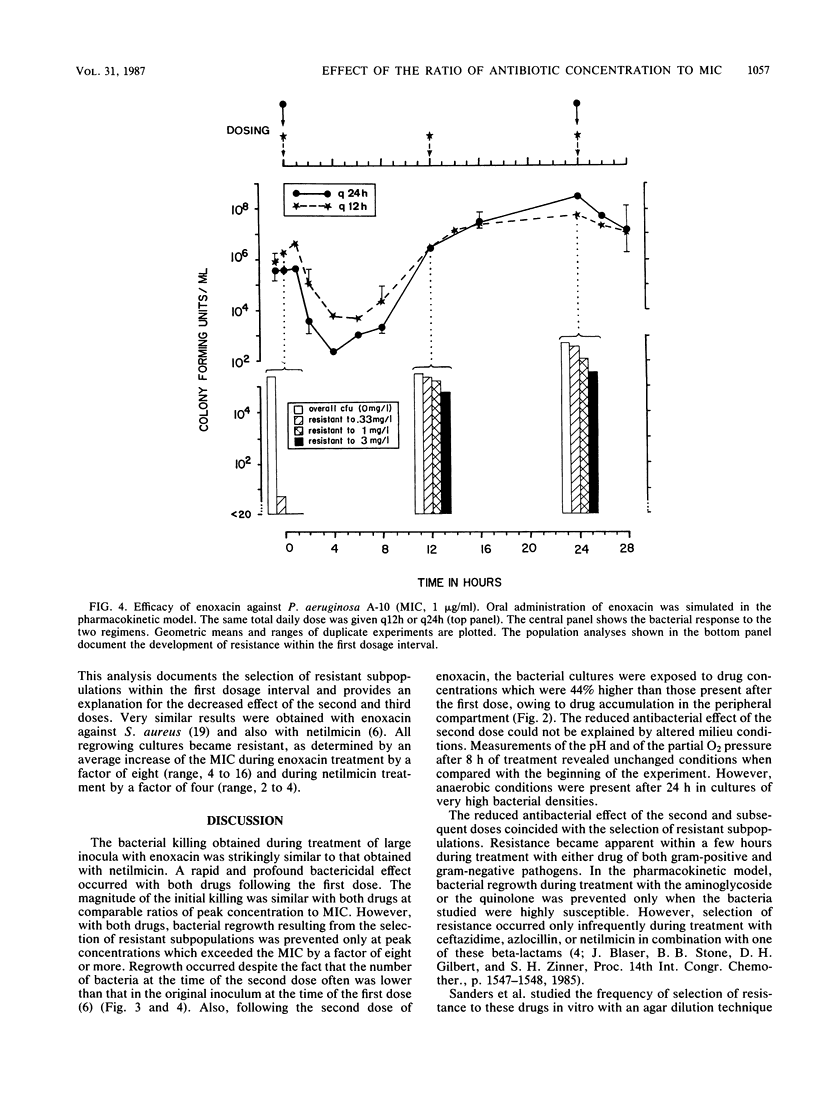Abstract
An in vitro pharmacokinetic model was used to study the comparative antibacterial activities of multiple-dose regimens of enoxacin and netilmicin. Strains of Pseudomonas aeruginosa, Klebsiella pneumoniae, Escherichia coli, and Staphylococcus aureus were exposed to changing drug concentrations, mimicking human two-compartment pharmacokinetics. Oral administration was simulated for the quinolone, and intravenous administration was simulated for the aminoglycoside. Similar ratios of peak concentration to MIC resulted in similar changes in bacterial concentrations over time with both compounds. Following the initial dose, a rapid bactericidal effect occurred, with a greater than 99% reduction of the bacterial counts within 4 h at peak concentrations more than three times the MIC. However, bacterial regrowth occurred within 24 h unless the peak concentration/MIC ratio exceeded 8:1 (P less than 0.01). For the regrowing bacteria, MICs were four- to eightfold higher, and little or no bactericidal effect occurred following the second and subsequent doses. These data demonstrate the equally potent bactericidal activity of orally administered enoxacin and intravenously administered netilmicin. Selection of resistant subpopulations was similar with each drug. The peak concentration/MIC ratio may be an important parameter in the clinical use of quinolone and aminoglycoside antibiotics.
Full text
PDF






Selected References
These references are in PubMed. This may not be the complete list of references from this article.
- Bayer A. S., Norman D., Kim K. S. Efficacy of amikacin and ceftazidime in experimental aortic valve endocarditis due to Pseudomonas aeruginosa. Antimicrob Agents Chemother. 1985 Dec;28(6):781–785. doi: 10.1128/aac.28.6.781. [DOI] [PMC free article] [PubMed] [Google Scholar]
- Blaser J., Dudley M. N., Gilbert D., Zinner S. H. Influence of medium and method on the in vitro susceptibility of Pseudomonas aeruginosa and other bacteria to ciprofloxacin and enoxacin. Antimicrob Agents Chemother. 1986 May;29(5):927–929. doi: 10.1128/aac.29.5.927. [DOI] [PMC free article] [PubMed] [Google Scholar]
- Blaser J., Stone B. B., Groner M. C., Zinner S. H. Impact of netilmicin regimens on the activities of ceftazidime-netilmicin combinations against Pseudomonas aeruginosa in an in vitro pharmacokinetic model. Antimicrob Agents Chemother. 1985 Jul;28(1):64–68. doi: 10.1128/aac.28.1.64. [DOI] [PMC free article] [PubMed] [Google Scholar]
- Blaser J., Stone B. B., Zinner S. H. Efficacy of intermittent versus continuous administration of netilmicin in a two-compartment in vitro model. Antimicrob Agents Chemother. 1985 Mar;27(3):343–349. doi: 10.1128/aac.27.3.343. [DOI] [PMC free article] [PubMed] [Google Scholar]
- Blaser J., Stone B. B., Zinner S. H. Two compartment kinetic model with multiple artificial capillary units. J Antimicrob Chemother. 1985 Jan;15 (Suppl A):131–137. doi: 10.1093/jac/15.suppl_a.131. [DOI] [PubMed] [Google Scholar]
- Desplaces N., Gutmann L., Carlet J., Guibert J., Acar J. F. The new quinolones and their combinations with other agents for therapy of severe infections. J Antimicrob Chemother. 1986 Mar;17 (Suppl A):25–39. doi: 10.1093/jac/17.suppl_a.25. [DOI] [PubMed] [Google Scholar]
- Gerber A. U., Vastola A. P., Brandel J., Craig W. A. Selection of aminoglycoside-resistant variants of Pseudomonas aeruginosa in an in vivo model. J Infect Dis. 1982 Nov;146(5):691–697. doi: 10.1093/infdis/146.5.691. [DOI] [PubMed] [Google Scholar]
- Hooper D. C., Wolfson J. S. The fluoroquinolones: pharmacology, clinical uses, and toxicities in humans. Antimicrob Agents Chemother. 1985 Nov;28(5):716–721. doi: 10.1128/aac.28.5.716. [DOI] [PMC free article] [PubMed] [Google Scholar]
- McDonald P. J., Wetherall B. L., Pruul H. Postantibiotic leukocyte enhancement: increased susceptibility of bacteria pretreated with antibiotics to activity of leukocytes. Rev Infect Dis. 1981 Jan-Feb;3(1):38–44. doi: 10.1093/clinids/3.1.38. [DOI] [PubMed] [Google Scholar]
- Moore R. D., Lietman P. S., Smith C. R. Clinical response to aminoglycoside therapy: importance of the ratio of peak concentration to minimal inhibitory concentration. J Infect Dis. 1987 Jan;155(1):93–99. doi: 10.1093/infdis/155.1.93. [DOI] [PubMed] [Google Scholar]
- Nakamura R., Yamaguchi T., Sekine Y., Hashimoto M. Determination of a new antibacterial agent (AT-2266) and its metabolites in plasma and urine by high-performance liquid chromatography. J Chromatogr. 1983 Dec 9;278(2):321–328. doi: 10.1016/s0378-4347(00)84791-x. [DOI] [PubMed] [Google Scholar]
- Olson B., Weinstein R. A., Nathan C., Chamberlin W., Kabins S. A. Occult aminoglycoside resistance in Pseudomonas aeruginosa: epidemiology and implications for therapy and control. J Infect Dis. 1985 Oct;152(4):769–774. doi: 10.1093/infdis/152.4.769. [DOI] [PubMed] [Google Scholar]
- Sanders C. C., Sanders W. E., Jr, Goering R. V., Werner V. Selection of multiple antibiotic resistance by quinolones, beta-lactams, and aminoglycosides with special reference to cross-resistance between unrelated drug classes. Antimicrob Agents Chemother. 1984 Dec;26(6):797–801. doi: 10.1128/aac.26.6.797. [DOI] [PMC free article] [PubMed] [Google Scholar]
- Wise R., Lockley R., Dent J., Webberly M. Pharmacokinetics and tissue penetration of enoxacin. Antimicrob Agents Chemother. 1984 Jul;26(1):17–19. doi: 10.1128/aac.26.1.17. [DOI] [PMC free article] [PubMed] [Google Scholar]
- Wolfson J. S., Hooper D. C. The fluoroquinolones: structures, mechanisms of action and resistance, and spectra of activity in vitro. Antimicrob Agents Chemother. 1985 Oct;28(4):581–586. doi: 10.1128/aac.28.4.581. [DOI] [PMC free article] [PubMed] [Google Scholar]
- Zinner S. H., Dudley M., Blaser J. In vitro models for the study of combination antibiotic therapy in neutropenic patients. Am J Med. 1986 Jun 30;80(6B):156–160. doi: 10.1016/0002-9343(86)90494-8. [DOI] [PubMed] [Google Scholar]


